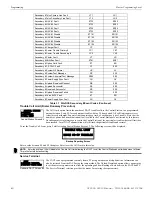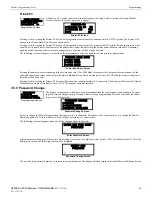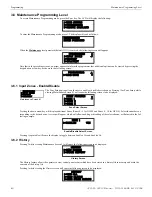
Operating Instructions
Supervisory Operation
•
Communicate the alarm to the Central Station
•
Alarms latch and
are not allowed to clear automatically
•
Timers for Silence Inhibit, Autosilence and Trouble Reminder are started
•
Alarms activate the alarm relay
•
Silenced alarms are resounded
•
The trouble relay is not activated
•
Store event in history buffer
•
Terminate upload or download communications
A typical alarm display would be as illustrated below:
Note that the device type, which in this example is
PULL STATION
, can be any other programmable alarm type.
The information displayed in the above example provides the following information:
•
First line in display:
– The type of event; in this example
ALARM
indicating an alarm condition
– Device type identifier; in this example,
PULL STATION
indicates a manual pull box. Other device type identifiers which can be
displayed include
SMOKE
for Smoke Detector,
HEAT
for Heat Detector, etc.
•
Second line in display:
– <ADJ>; refers to the user programmed adjective descriptor from library list resident in the control panel or custom entry via PC.
– <NOUN>; refers to the user programmed noun descriptor from library list resident in the control panel or custom entry via PC.
•
Third line in display:
Zone 10
indicates the zone programmed to this device which, in this example, is Input Zone 10.
•
Fourth line in display:
– Time; the current time in this example is
10:00A
which represents 10:00 AM
– Date; the current month, day and year in this example is
06
for June,
09
for the 9th day of the month and
18
for the year 2018
4.6 Supervisory Operation
Supervisory operation is similar to alarm operation but with the following differences:
•
The piezo sounder pulses ½ second On and ½ second Off
•
The Supervisory LED flashes ½ second On and ½ second Off
•
The LCD displays the status label
Active Supervisory
along with the device name, type, adjective/noun, associated zones and
time/date
•
Communicate the supervisory condition to the Central Station
•
The supervisory relay is activated
•
The alarm relay is not activated
•
Silenced alarms are not resounded
•
Timers are not started
•
Store event in history buffer
•
Terminate upload or download communications
A typical Supervisory event would be displayed as illustrated in the following:
In the preceding example:
•
FROZEN SUPRV -
indicates zone detector is below approximately 45
o
F
Note that, like alarms, supervisory signals latch, except when programmed for supervisory autoresettable. Supervisory activations do not
cause silenced alarms to resound, as do other alarm conditions. Open circuits in supervisory wiring are processed by the control panel the
same way as other trouble conditions. Refer to “Alarm Operation” on page 87, for a description of the information displayed on the con-
trol panel LCD.
4.7 Process Monitor Operation
Process Monitor operation will initiate the following events:
•
The piezo sounder pulses ¼ second On and ¼ second Off
•
The LCD displays a process monitor message along with the device name, type, adjective/noun, associated zones and time/date
•
Communicate the process monitor condition to the Central Station (if the default event code has been changed from 000 to a
reportable event code)
•
Relays programmed for process monitoring will be activated
ALARM PULL STATION
<ADJ> <NOUN>
ZONE 10
10:00A 060918
FREEZE SUPERVISORY
<ADJ> <NOUN>
ZONE 05 FROZEN SUPRV
10:00A 060918
88
GF505 & GF510 Manual —
P/N
53164
:B5 6/12/2018






























